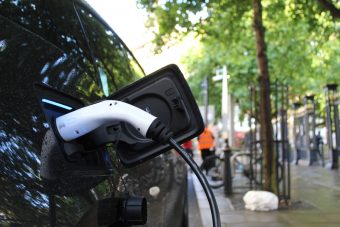
With 68 percent of people expected to live in cities by 2050, urban areas will be at the heart of the electric vehicle (EV) transition, which is well underway. The adoption of EVs has skyrocketed in the past five years, growing from around 3.1 million EVs globally in 2017 to over 20 million in 2022. Of course, it is crucial that public, shared and active modes of transport are also prioritised – not only to decarbonize, but also to tackle congestion, air pollution, safety, and more – but EVs will be important for cities in cutting emissions and delivering cleaner air for residents.
City governments have a crucial role to play in supporting the transition to EVs, perhaps none more important than creating a crucial piece of infrastructure: EV charging. Enabling and supporting the creation of a widespread network of charging stations is a vital piece of the puzzle when it comes to growing the adoption of EVs, making their use more convenient, seamless and reliable.
Which cities are leading the charge?
Across the world, cities are demonstrating leadership in advancing the transition to EVs. Cities are taking a variety of approaches to scale up EVs and charging infrastructure. C40 Cities’ recent report, EV charging infrastructure: Business models and city case studies, highlighted different approaches that cities can take in scaling up EV infrastructure, including.
Government driven:
In countries where local governments have substantial authority, cities have an opportunity to lead the development of a deployment strategy of vehicle chargers. London and Barcelona, for example, have set ambitious goals and have been leading the way to achieve national emission reduction targets by developing strong business and financing models, bringing the private sector and utilities to join forces in achieving their objectives.
For instance, in 2018 the Mayor of London announced a public-private electrification infrastructure taskforce, which informed the subsequent EV Infrastructure Delivery Plan and EV infrastructure strategy for 2030 to roll out action on the ground. Thanks to this strong planning, London has rapidly scaled its charging network, having almost a third of all public chargers in the UK.
In Barcelona, the city government set out an Electric Mobility Strategy in 2018 to guide the drive to electrification, including targets to have 80 percent of the municipal vehicle fleet electric by 2024. With the city now having over 700 charging points, complemented by incentives such as free parking and tax incentives, Barcelona is home to 15 percent of all EVs in Spain.
More:
- ELECTRIC VEHICLES ARE THE FUTURE OF THE AUTOMOTIVE INDUSTRY
- CREATE THE WORLD’S FIRST ELECTRIC VEHICLE EMOJI FOR WORLD EV DAY 2021
- WATTS TO WHEELS: WHY EV-BATTERY INNOVATION IS KEY TO SPARKING A RENEWABLE REVOLUTION
Private sector driven:
Cities can have an important impact by sending strong signals to the market and ultimately shaping the private sector’s approach to EV charging roll-out. In Bangkok, the deployment of infrastructure investment was driven by public-private partnerships, public agencies and the private sector. The national government introduced a framework and the city worked with the private sector to support the deployment of the stations. Bangkok Metropolitan Administration has offered incentives to encourage investment from the private sector, such as a 50 percent reduction in electricity tariffs on public EV chargers, which has contributed to numerous private companies installing chargers in the city, with around 3,000 chargers now present – around 80 percent of all chargers in Thailand.
Energy utility driven:
For some cities, the energy market is guiding EV transition. In Dubai for example, the city’s power utility is leading efforts to develop public charging infrastructure, with over 370 chargers currently in operation. The Dubai Electricity and Water Authority (DEWA) launched the EV Green Charger Initiative in 2015, which has helped to roll out chargers and ramp up EV adoption from just 71 vehicles in 2015 to over 5,100 vehicles in 2022. The utility authority has ambitious plans to triple the number of chargers in the next two years.

City governments have a crucial role to play in supporting the transition to EVs, perhaps none more important than creating a crucial piece of infrastructure: EV charging. Enabling and supporting the creation of a widespread network of charging stations is a vital piece of the puzzle when it comes to growing the adoption of EVs, making their use more convenient, seamless and reliable.
What are the challenges of scaling EV infrastructure?
Chief among the challenges to scaling EV infrastructure is, unsurprisingly, financial barriers, including the affordability for city administrations of creating widespread charging networks. Issues with infrastructure, such as the need to upgrade and strengthen electricity grids, and competition for street space when seeking to install chargers, pose significant challenges to cities rapidly scaling up EV infrastructure, due to the complexity and resources associated with these challenges.
A lack of coordination between different government departments or between key public and private stakeholders. Additionally, governance challenges may exist: permitting rules for charging installation; a complex regulatory environment for charging providers; or a lack of certainty about future policy and regulation on EVs.
How can we scale investment in EV infrastructure?
C40 Cities’ report highlights recommendations to aid the implementation of EV infrastructure, including clear deployment targets as part of the city’s Climate Action Plan; strong governance systems to manage deployment and ensure a collaborative approach. In the report, different solutions to challenges and opportunities are described in the case studies, covering a range of different city contexts and business models.
Crucially, the report also recommends creating a clear regulatory framework for the deployment of charging infrastructure to bring certainty and confidence to the private sector in investing in EV infrastructure. With this in mind, how can city governments create the right policy and regulatory environment to encourage and enable private investment in this transition?
To address this question, the Forum’s Global New Mobility Coalition, has launched a new taskforce on fostering investment in EV infrastructure. By bringing together charging operators, energy utilities, financial firms, vehicle manufacturers, infrastructure players, city governments and more, the taskforce will seek to set out how cities can grow public and private investment in EV infrastructure. The taskforce is investigating both how city governance can be used to enable and encourage investment from the private sector, as well as models for public-private financing of infrastructure. A key output of the taskforce will be policy guidance for city decision-makers to help streamline and scale public and private investment in charging infrastructure.
Source: World Economic Forum



